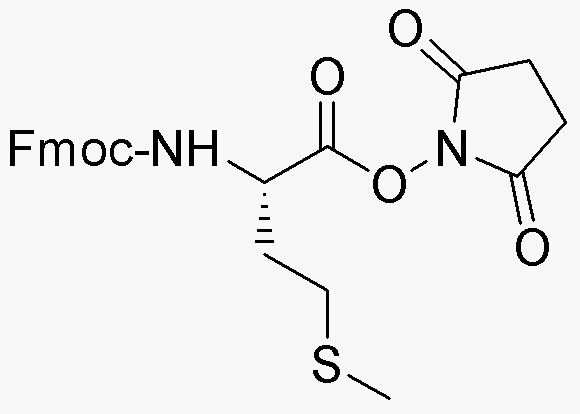Fmoc-L-methionine N-hydroxysuccinimide ester is widely utilized in research focused on:
- Peptide Synthesis: This compound serves as a key building block in solid-phase peptide synthesis, allowing researchers to create complex peptides efficiently.
- Drug Development: It is used in the development of peptide-based therapeutics, offering a stable and effective means to modify drug properties for enhanced efficacy.
- Bioconjugation: The compound facilitates the conjugation of peptides to various biomolecules, which is essential in creating targeted drug delivery systems.
- Protein Engineering: Researchers employ it to introduce specific modifications in proteins, improving their stability and functionality in various applications.
- Diagnostic Applications: It is utilized in the development of peptide-based diagnostics, enhancing the sensitivity and specificity of detection methods in clinical settings.
General Information
Properties
Safety and Regulations
Applications
Fmoc-L-methionine N-hydroxysuccinimide ester is widely utilized in research focused on:
- Peptide Synthesis: This compound serves as a key building block in solid-phase peptide synthesis, allowing researchers to create complex peptides efficiently.
- Drug Development: It is used in the development of peptide-based therapeutics, offering a stable and effective means to modify drug properties for enhanced efficacy.
- Bioconjugation: The compound facilitates the conjugation of peptides to various biomolecules, which is essential in creating targeted drug delivery systems.
- Protein Engineering: Researchers employ it to introduce specific modifications in proteins, improving their stability and functionality in various applications.
- Diagnostic Applications: It is utilized in the development of peptide-based diagnostics, enhancing the sensitivity and specificity of detection methods in clinical settings.
Documents
Safety Data Sheets (SDS)
The SDS provides comprehensive safety information on handling, storage, and disposal of the product.
Product Specification (PS)
The PS provides a comprehensive breakdown of the product’s properties, including chemical composition, physical state, purity, and storage requirements. It also details acceptable quality ranges and the product's intended applications.
Certificates of Analysis (COA)
Search for Certificates of Analysis (COA) by entering the products Lot Number. Lot and Batch Numbers can be found on a product’s label following the words ‘Lot’ or ‘Batch’.
Numéro de catalogue
Numéro de lot/série
Certificates Of Origin (COO)
This COO confirms the country where the product was manufactured, and also details the materials and components used in it and whether it is derived from natural, synthetic, or other specific sources. This certificate may be required for customs, trade, and regulatory compliance.
Numéro de catalogue
Numéro de lot/série
Safety Data Sheets (SDS)
The SDS provides comprehensive safety information on handling, storage, and disposal of the product.
DownloadProduct Specification (PS)
The PS provides a comprehensive breakdown of the product’s properties, including chemical composition, physical state, purity, and storage requirements. It also details acceptable quality ranges and the product's intended applications.
DownloadCertificates of Analysis (COA)
Search for Certificates of Analysis (COA) by entering the products Lot Number. Lot and Batch Numbers can be found on a product’s label following the words ‘Lot’ or ‘Batch’.
Numéro de catalogue
Numéro de lot/série
Certificates Of Origin (COO)
This COO confirms the country where the product was manufactured, and also details the materials and components used in it and whether it is derived from natural, synthetic, or other specific sources. This certificate may be required for customs, trade, and regulatory compliance.


